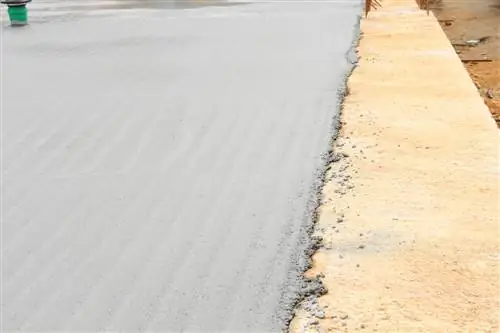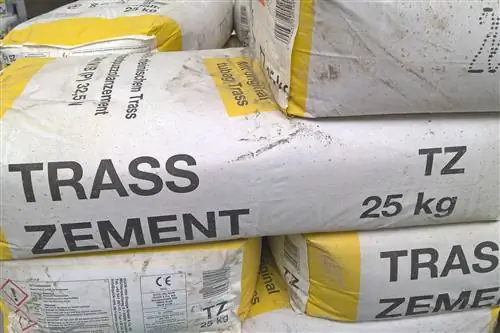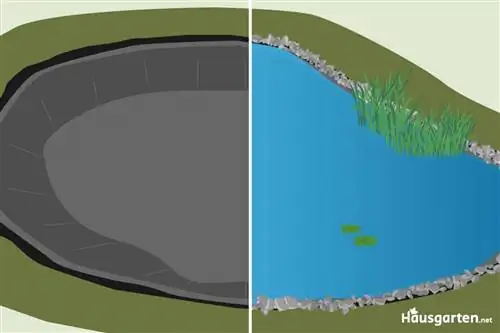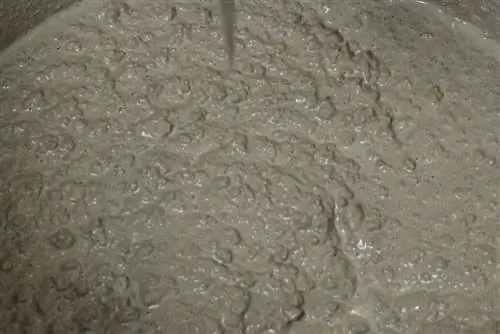- Author admin [email protected].
- Public 2023-12-17 03:39.
- Last modified 2025-01-24 12:45.
So-called cement water, cement slurry or cement glue can be used to securely bond old and fresh concrete together. We show how the adhesive base can be made.
Application options
The cement adhesive can be used, among other things, if, for example, an old concrete surface needs to be renovated. If there are cracks in this, or if it has become unsightly or uneven over time, a new layer can solve the problems and be used for leveling.
It is also possible, for example:
- create a necessary gradient
- Raise walls
- Make up for damages
- To thicken walls
Preparation
Before the cement adhesive and a new layer of concrete are applied, the hardened concrete must first be prepared appropriately. The following steps are required:
Dry cleaning
Coarse and dry dirt can be removed with a broom with hard bristles. Moss and other deposits should also be removed by scraping or brushing them from joints and stones.
Wet cleaning
Since not all dirt can be removed with dry cleaning, the hardened concrete should then be cleaned with a damp cloth. For stubborn dirt, we recommend soaking the surface in advance with a mixture of soda and warm water. Moss and other residues can then be removed with a brush.
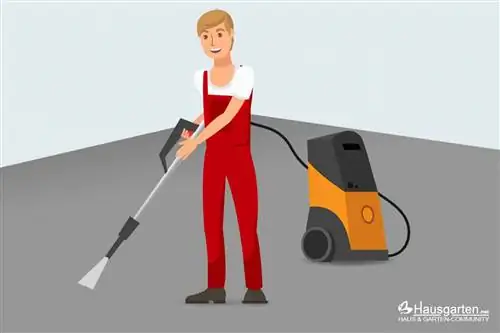
Repair damage
If there are cracks or holes in the hardened concrete, they must be cleaned and fragments removed before applying the cement water.
Let dry
Before the adhesive primer is spread, the concrete must be allowed to dry completely. It therefore makes sense to carry out the preparatory measures on a dry and sunny day and to let the concrete dry for at least several hours, preferably overnight or a day.
Tip:
In order to protect the cleaned hardened concrete from further contamination and moisture before application, waterproof tarpaulins can be stretched over it. However, they should not be placed directly on the surface so that the surface can dry completely and undisturbed.
Make cement water
The production of cement water is very simple and requires only a few accessories and only two substances - water and cement.

Also necessary:
- a bucket or a bricklayer's doll
- a drill with a stirring attachment or another utensil for stirring
- a shovel
- a Piassava broom
- if necessary a measuring cup
Instructions
- Measure the water and put it in a bucket or mason's pot.
- Add cement powder to the water and stir to avoid lumps forming. A scoop of cement is added to ten liters of water.
- Stir the mixture until the dry powder is evenly distributed and a homogeneous solution is formed.
- Mix the fresh cement so that it can be distributed immediately after applying the cement water.
- Spread the adhesive primer on the concrete surface and work it in with a broom.
- Apply the cement directly onto the primer, distribute evenly and smooth.
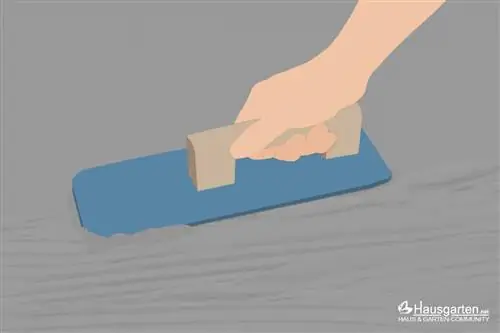
Now the fresh concrete just needs to dry completely until it can be walked on or driven on. Depending on the thickness of the layer, temperature and humidity, this can take a few days. Until then, the newly concreted area should be cordoned off and covered with tarpaulins if possible.
Tip:
It is ideal if the work is carried out by two people. This makes it possible to prepare the cement paste and the cement itself at the same time and distribute them on the floor in a timely manner.
Alternatives
As an alternative to cement paste, there are other means with which hardened concrete and fresh concrete can be bonded together. Below:
- Adhesive primer
- Moniereisen
- Turnbuckles
The advantage of an adhesive primer is that mixing is usually not necessary. This makes the application quick and easy. The disadvantage is that the products are usually more expensive than making cement water yourself. However, the areas of application are the same for both remedies.
Moniereisen are pieces of metal that are half inserted into the existing concrete. To do this, holes must first be pre-drilled. The second half of the iron sticks out and serves as a holder for the fresh concrete. In addition to the monier iron, cement water or adhesive primer can be used. This increases liability. The plug-in connections can be used primarily when raising or extending a wall, but also for building foundations.

Turnbuckles are the method of choice for finished concrete parts that need to be brought together. They are similar to monier irons, but consist of two parts that are brought together and screwed together. This means that there must be a recess in the concrete parts, which may already be available on the market for some pieces but usually have to be made yourself. The advantage is that finished concrete parts can be easily connected to one another. However, the effort is greater for parts that do not yet have recesses. In addition, the costs are greater than producing the cement water. However, walls can be built very quickly using this method and connection technology. In addition, the technology is suitable for any area where concrete cannot be poured and no primer is required.

